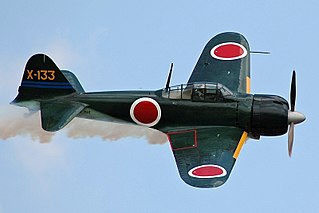
The Mitsubishi A6M "Zero" is a long-range carrier-based fighter aircraft formerly manufactured by Mitsubishi Aircraft Company, a part of Mitsubishi Heavy Industries. It was operated by the Imperial Japanese Navy (IJN) from 1940 to 1945. The A6M was designated as the Mitsubishi Navy Type 0 carrier fighter, or the Mitsubishi A6M Rei-sen. The A6M was usually referred to by its pilots as the Reisen, "0" being the last digit of the imperial year 2600 (1940) when it entered service with the Imperial Navy. The official Allied reporting name was "Zeke", although the name "Zero" was used colloquially as well.

Wake Island, also known as Wake Atoll, is a coral atoll in the Micronesia subregion of the Pacific Ocean. The atoll is composed of three islets – Wake, Wilkes, and Peale Islands – surrounding a lagoon encircled by a coral reef. The nearest inhabited island is Utirik Atoll in the Marshall Islands, located 592 miles to the southeast.

Munda is the largest settlement on the island of New Georgia in the Western Province of Solomon Islands, and consists of a number of villages. It is located at the southwestern tip of the western end of New Georgia, and the large Roviana Lagoon is just offshore.

Scapa Flow is a body of water in the Orkney Islands, Scotland, sheltered by the islands of Mainland, Graemsay, Burray, South Ronaldsay and Hoy. Its sheltered waters have played an important role in travel, trade and conflict throughout the centuries. Vikings anchored their longships in Scapa Flow more than a thousand years ago. It was the United Kingdom's chief naval base during the First and Second World wars, but the facility was closed in 1956.
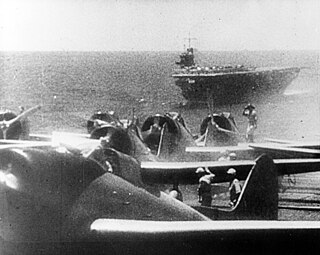
The Aichi D3A is a World War II carrier-borne dive bomber. It was the primary dive bomber of the Imperial Japanese Navy (IJN) and was involved in almost all IJN actions, including the attack on Pearl Harbor.

PT-109 was an 80-foot Elco PT boat last commanded by Lieutenant John F. Kennedy, future United States president, in the Solomon Islands campaign of the Pacific theater during World War II. Kennedy's actions in saving his surviving crew after PT-109 was rammed and sunk by a Japanese destroyer earned him several commendations and made him a war hero. Back problems stemming from the incident required months of hospitalization at Chelsea Naval Hospital and plagued him the rest of his life. Kennedy's postwar campaigns for elected office referred often to his service on PT-109.

Tulagi, less commonly known as Tulaghi, is a small island in Solomon Islands, just off the south coast of Ngella Sule. The town of the same name on the island was the capital of the British Solomon Islands Protectorate from 1896 to 1942 and is today the capital of the Central Province. The capital of what is now the state of Solomon Islands moved to Honiara, Guadalcanal, after World War II.
The Mitsubishi G4M is a twin-engine, land-based medium bomber formerly manufactured by the Mitsubishi Aircraft Company, a part of Mitsubishi Heavy Industries, and operated by the Imperial Japanese Navy from 1940 to 1945. Its official designation is Mitsubishi Navy Type 1 attack bomber and was commonly referred to by Japanese Navy pilots as Hamaki due to the cylindrical shape of its fuselage and its tendency to ignite after a hit. The Allied reporting name was "Betty".
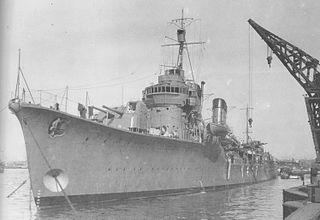
Amagiri was the 15th of 24 Fubuki-class destroyers, built for the Imperial Japanese Navy following World War I. When introduced into service, these ships were the most powerful destroyers in the world. They served as first-line destroyers through the 1930s, and remained formidable weapons systems well into the Pacific War. She is most famous for ramming the PT-109 commanded by Lieutenant John F. Kennedy, who would later become the 35th President of the United States.

Rendova is an island in Western Province, in the independent nation of Solomon Islands, in the South Pacific, east of Papua New Guinea.
Biuku Gasa and Eroni Kumana were Solomon Islanders of Melanesian descent who found John F. Kennedy and his surviving PT-109 crew following the boat's collision with the Japanese destroyer Amagiri near Plum Pudding Island on 1 August 1943. They were from the Western Province of the Solomon Islands.
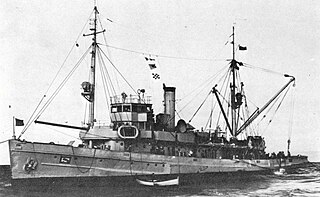
The first USS Ortolan(AM-45/ASR-5) was a Lapwing-class minesweeper in the United States Navy. She was later converted to a submarine rescue ship. She was named after the ortolan, a European bunting.

USS LST-472 was a United States Navy LST-1-class tank landing ship used in the Asiatic-Pacific Theater during World War II. As with many of her class, the ship was never named. Instead, she was referred to by her hull designation.
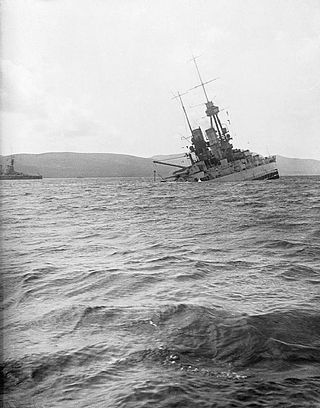
On 21 June 1919, shortly after the end of the First World War, the Imperial German Navy's High Seas Fleet was scuttled by its sailors while held off the harbour of the British Royal Navy base at Scapa Flow, in the Orkney Islands of Scotland. The fleet was interned there under the terms of the Armistice of 11 November 1918 while negotiations took place over its fate. Fearing that either the British would seize the ships unilaterally or the German government at the time might reject the Treaty of Versailles and resume the war effort, Admiral Ludwig von Reuter decided to scuttle the fleet.

USS Majaba (AG-43/IX-102) was the Design 1049 cargo ship Meriden built in 1919 by the Albina Engine & Machine Works, Portland, Oregon. All the ships were requisitioned by the United States Shipping Board (USSB) for World War I service. The ship was bought by the E. K. Wood Lumber Co., of San Francisco, California in 1923 and renamed El Capitan. The ship was chartered by the U.S. Navy through the War Shipping Administration (WSA) in April 1942 and commissioned as Majaba.

The Senshi Sōsho, also called the Kōkan Senshi (公刊戦史), is the official military history of Imperial Japan's involvement in the Pacific War from 1937 to 1945. The task of compiling the official account of the Japanese involvement in World War II began in October 1955 with the opening of the War History Office. Its main function was to serve as educational research material for the Self-Defense Forces. The office was led by Colonel Nishiura Susumu, a senior official in the War Ministry during the war. The publisher was Asagumo Shimbunsha.

Balalae Island is an island of the Shortland Islands Group in Western Province, Solomon Islands.

Innes McCartney is a British nautical archaeologist and historian. He is a Visiting Fellow at Bournemouth University in the UK.

SS Rufus King was a standard Liberty ship built in the United States during World War II. She was named after Founding Father Rufus King, and was wrecked in July 1942, upon Amity Bar South of Moreton Island and north of North Stradbroke Island, Queensland, Australia. She was operated by International Freighting Corporation under charter with the Maritime Commission and War Shipping Administration.

Naval Advance Base Espiritu Santo or Naval Base Espiritu Santo, most often just called Espiritu Santo, was a major advance Naval base that the U.S. Navy Seabees built during World War II to support the Allied effort in the Pacific. The base was located on the island of Espiritu Santo in the New Hebrides, now Vanuatu, in the South Pacific. The base also supported the U.S. Army and Army Air Corps, U.S. Coast Guard, and US Marine Corps. It was the first large advance base built in the Pacific. By the end of the war it had become the second-largest base in the theater. To keep ships tactically available there was a demand for bases that could repair and resupply the fleet at advance locations, rather than return them to the United States. Prior to December 7th, Pearl Harbor was the U.S. fleet's largest advance base in the Pacific. Espiritu became capable of all aspects necessary to support the Fleet's operations from fleet logistics in fuel, food, and ammunition, to transport embarkation for combat operations or returning to the continental United States. The ship repair facilities and drydocks were capable of attending to most damage and routine maintenance. Had it not existed, ships would have had to return to Pearl Harbor, Brisbane, or Sydney for major repairs and resupply. The base became a major R and R destination for the fleet.

















